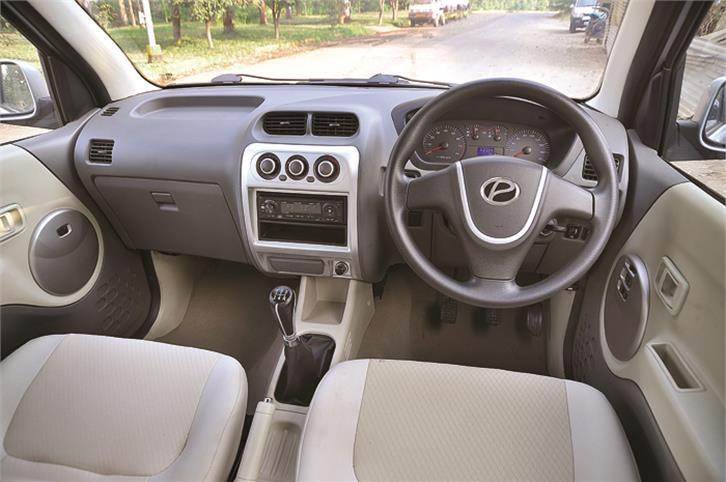New Premier Rio review, test drive
The Rio gets a new look and a new engine to take on BSIV markets. Can India’s first compact SUV make its mark?
Published on Dec 26, 2011 08:29:00 PM
16,749 Views
Follow us on


EXCLUSIVE
Premier Rio has moved out of the ‘beta’ phase. After a year and a half of playing on the fringes, a new BSIV-compliant 1.2-litre petrol motor will help the Rio tackle the big cities and bigger numbers. To further broaden the car’s appeal, Premier will unveil a facelift at the Auto Expo that should help it fit right into the urban landscape. We got to take an early peek at the refreshed mini-SUV.
The earlier Rio’s front end looked a bit gawky and dated. However, a few key design changes by the Zotye Group (manufacturers of the Nomad, as the Rio is known in China) have changed all of that. The new curvy headlamps bulge and cut into the bumper, and the clean design of
the new integrated grille and the silver chin spoiler give the Rio a pleasant and sophisticated look. These changes have necessitated a new hood and side panels, which along with the new bumper, improves aerodynamic efficiency, claims the company.
The grey plastic valance covers for the wheel arches and the side cladding are now body coloured, making the Rio much more appealing even when viewed from the side. Turn indicators on the mirrors give the Rio added flair. Earlier, the Rio seemed most pleasing to the eye when viewed from the rear. It’s a credit to the changes made, but this isn’t the case anymore. However, the rounded glass and the spare-wheel mounted on the tailgate still give it a lot of spunk, and the new bumper has given it a cleaner look as well.
Overall the original Daihatsu Terios’ DNA remains unchanged. The compact body seems to be teetering on a narrow track, although the chunky 15-inch tyres give it a strong footprint. Add 200mm of ground clearance to the mix and you can be sure that the worst of Mumbai’s rain-ravaged roads won’t shake up the Rio.
The car has a youthful and adventurous air that attracts a surprising amount of attention. The changes on the inside will help keep people’s attention longer. One of the improvements is the beige upholstery that brings cheer and a sense of spaciousness to the interiors. Extra cushioning for the palms at the 10-and-2 positions give the steering a more substantial feel as well. It also has a new steering boss with a chrome garnish. Ergonomic gaffes like the awkwardly positioned power window switches and the offset seating position remain unchanged.
At the business end of things the Rio is now powered by a four-cylinder 1.2-litre petrol motor. Although the engine is designed by AVL, it is manufactured in China and is brought in assembled from there. The longitudinally mounted engine delivers 75.5bhp of power and 10.5kgm of torque to the rear wheels. The first twist of the key brings the engine to life. It settles into a smooth, quiet idle, benefitting from the same insulation that was added to the diesel Rio. The tall gear lever slots into first with a light but notchy feel, but the clutch action is light.
On the move the Rio’s performance disappoints. Firstly, the power output is at the lower end for engines of similar spec. Secondly, efficiency losses are higher as drive is transferred to the rear wheels. This heavier drivetrain also adds to its 1080 kerb-weight, making the Rio significantly heavier than comparable hatchbacks.
Although outright punch is in short supply, it is the lack of responsiveness that really detracts from the driving experience. The engine responds to throttle inputs with dullness and lethargy. Prod the throttle and there’s a vague, disproportionate response from the motor, so much so that you end up nailing the short-travel accelerator into the floor in the hope of some reaction. There is a slight bump in responsiveness post 3200rpm but that isn’t significant either. The Rio doesn’t like making mad dashes through the city, preferring to amble along. For quick overtaking manoeuvres you generally need to shift down a gear, or two.
Out on the highway the Rio can hit an indicated 140kph, but it takes a fair amount of patience and the engine sounds strained getting there. Even in-gear acceleration is painstakingly slow. The gear ratios feel a bit tall too, the Rio losing speed rapidly as you switch to 5th.
Where the Rio excels is the way it coasts over bad roads. This mini-SUV surfs over tempestuous roads like a pro. But the suspension does give the Rio a bit of lumpiness at low speeds and body-roll around corners. At high speeds there is a fair amount of pitter-patter from the suspension creeping into the cabin.
The Premier Rio’s carefree and cheerful air has been enhanced dramatically by the cosmetic upgrades, inside and out. Mechanically, the new 1.2-litre engine’s lacklustre performance does little to set the Rio’s sales fortunes on fire. For now, Premier has the market all to itself and at the Rio’s sub-five-lakh-rupee price point, its SUV charms and city-friendly proportions go a long way in negating its performance and space deficit. But, Premier has an ace up its sleeve – a Rio powered by Fiat’s 74bhp Multijet is slated for a mid-2012 launch, and that will change the Rio’s value equation massively.
Tech Specs 
Copyright (c) Autocar India. All rights reserved.

 Performance
Performance Price
Price Engine
Engine Transmission
Transmission Efficiency
Efficiency Acceleration
Acceleration Body
Body Brakes
Brakes Dimensions
Dimensions
Comments
Member Login
Personal Details
No comments yet. Be the first to comment.